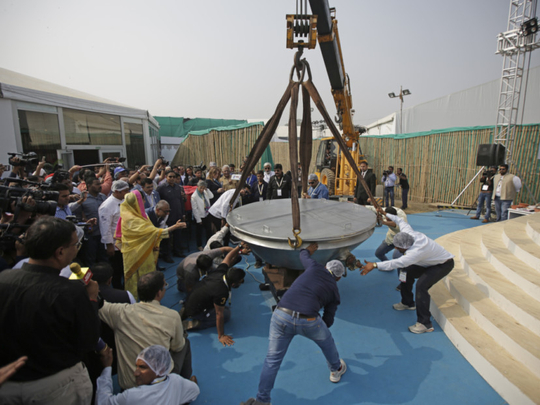
The Indian government may have made it to the Guinness World Records by stirring up a 918kg pot of khichdi (a rice-lentil mishmash) with some help from celebrity chef Sanjeev Kapoor and self-styled yoga guru-cum-entrepreneur Baba Ramdev at the World Food India expo on November 4, on the India Gate lawns in New Delhi, by mooting khichdi as “Brand India Food” if not a “national dish”.
The mere announcement led to speculation on social media that elevating “khichdi” as the “national dish of India”, was just another way of the government admitting that something was very sick with the Indian economy and its style of governance, as the dish is often considered best for an ailing person. As usual, much outrage was demonstrated on social media, accompanied with humour. So much so, that Harsimrat Kaur Badal, Union Minister for Food Processing had to slap down the controversies and comments on social media by saying: “Enough khichdi cooked up on a fictitious ‘National Dish’. It has only been put for a record entry in #WorldFoodIndia.”
The reasoning provided by Kaur for choosing khichdi was that it is a staple diet across the country. It is considered healthy and is consumed by everyone. “Brand India Khichdi symbolises India’s great culture of unity in diversity at its best,” the minister had said.
Many though think it’s supremely bland to represent India, known all over the world for its spices. Others abhor its homogeniety for a country known for its diversity. Naysayers also question the timing as to whether it represents the current state of the mind of the country — especially at a time when it is singing paeans of Prime Minister Narendra Modi for whom the country is believed to have witnessed a leap in World Bank rankings on ease of doing business. As India Explained tweeted: “Makes sense the BJP should pick khichdi as a national dish: Aptly symbolises how they make a total mishmash of everything.” Others like former Jammu & Kashmir chief minister Omar Abdullah wondered: “Do we have to stand every time we see it being eaten? Is it compulsory to eat before a movie? Is it anti-national to not like the stuff?”
In recent months, patriotism has become a controversial issue in India, where the government and its supporters expect Indians to wear it on their sleeves. The Supreme Court wants you to stand up in a movie hall as the national anthem is played before every screening. Even questioning the policies of a democratically-elected government is being seen as unpatriotic.
The outrage on social media may have scorned of the minister, but her choice of selecting this humble one-pot dish of rice and lentil is perhaps apt for a government that looks for one-size-fits-all solutions for all the socio-conomic problems of the country. The Bharatiya Janata Party government, at the Centre since 2014, had been promoting ‘One Song, One Election, One Language, One History, One river, One religion’ and most importantly ‘One Leader’, ignoring the contributions of many over centuries.
For all these years, westerners have known “Indian curry” as the principal dish of the country. Over years, Indian curry houses had sprung all over European cities and are seen to give the ubiquitous pizza and noodles a run for their money. However, there has been an institutional effort to rewrite India’s history and hence the khichdi is now the choice for national dish.
Ironically, khichdi ticks all the boxes for being the potpourri, representing India’s present socio-economic muddle. The word itself is derived from the Sanskrit khiccha and it’s a key part of an Ayurvedic diet. It is given as offerings to Hindu deities all over India. It is mostly vegetarian and hence liked by those who lynch people for eating beef. Also it is an indigenous recipe, which, unlike biryani, is not ‘tainted’ by the influence of the Mughals, who are now blamed for polluting the Indian landscape by building the Taj Mahal!
The South Indian states cannot protest, calling it an imposition by the North — just like that of the Hindi language, since the South’s bisi bele bath and pongal come close enough.
Politically speaking, ardent Modi baiters such as West Bengal Chief Minister Mamata Banerjee and even Shiv Sena leader Uddhav Thackeray probably enjoy their khichdi. Congress party vice-president Rahul Gandhi, who, of late, has embarked on a name-calling spree — much to the delight of followers of social media — will have difficulty attacking khichdi as celebrity chef Madhur Jaffrey, in her book World Vegetarian, describes it as the risotto of India.
India, post-Independence, has witnessed many wars based on regional fervour. There had been wars on rivers, languages and invariably food. Recently, Odisha and West Bengal were locked in a fierce battle over the origin of the rosogolla (cottage-cheese balls dipped in sugar syrup). However, khichdi is devoid of such regionalism as we are yet to burn effigies of the same.
Archisman Dinda is a freelance journalist based in Kolkata, India.









